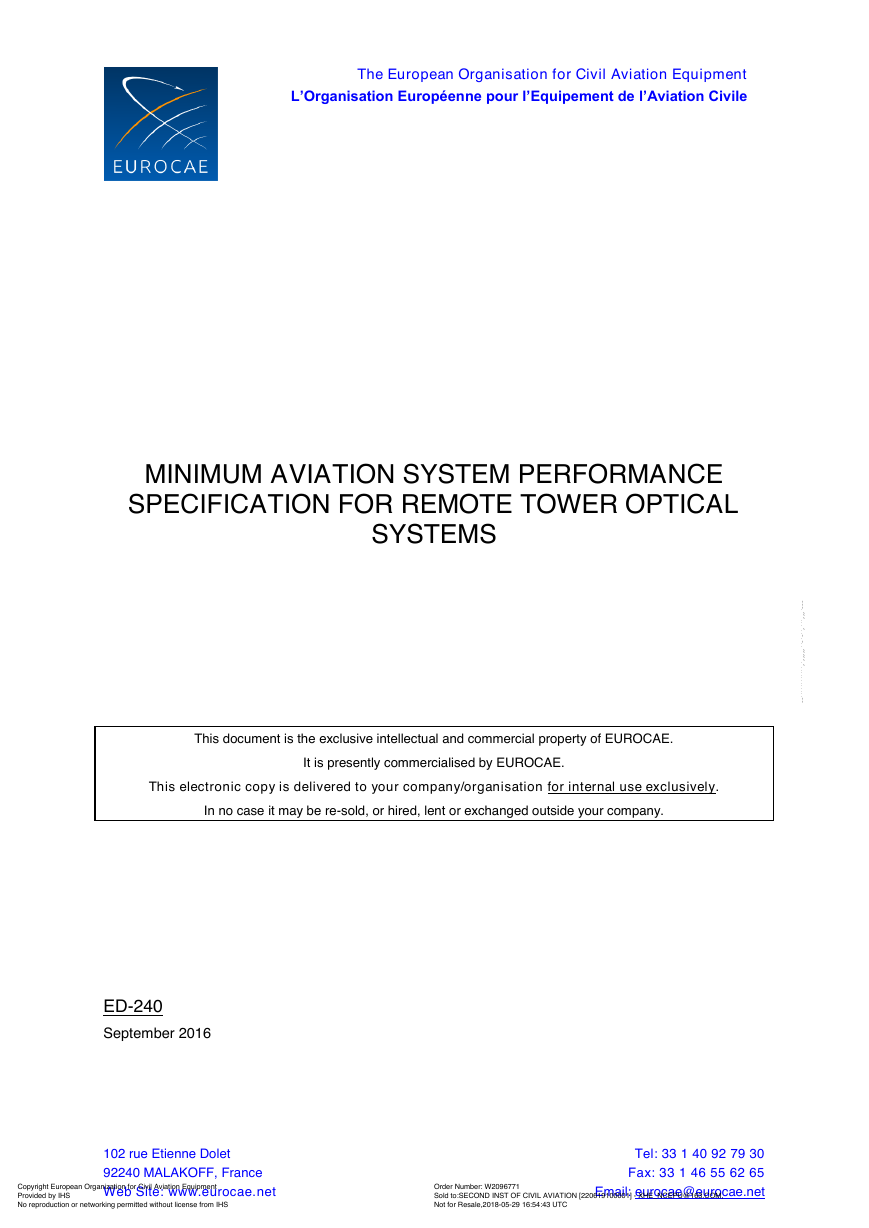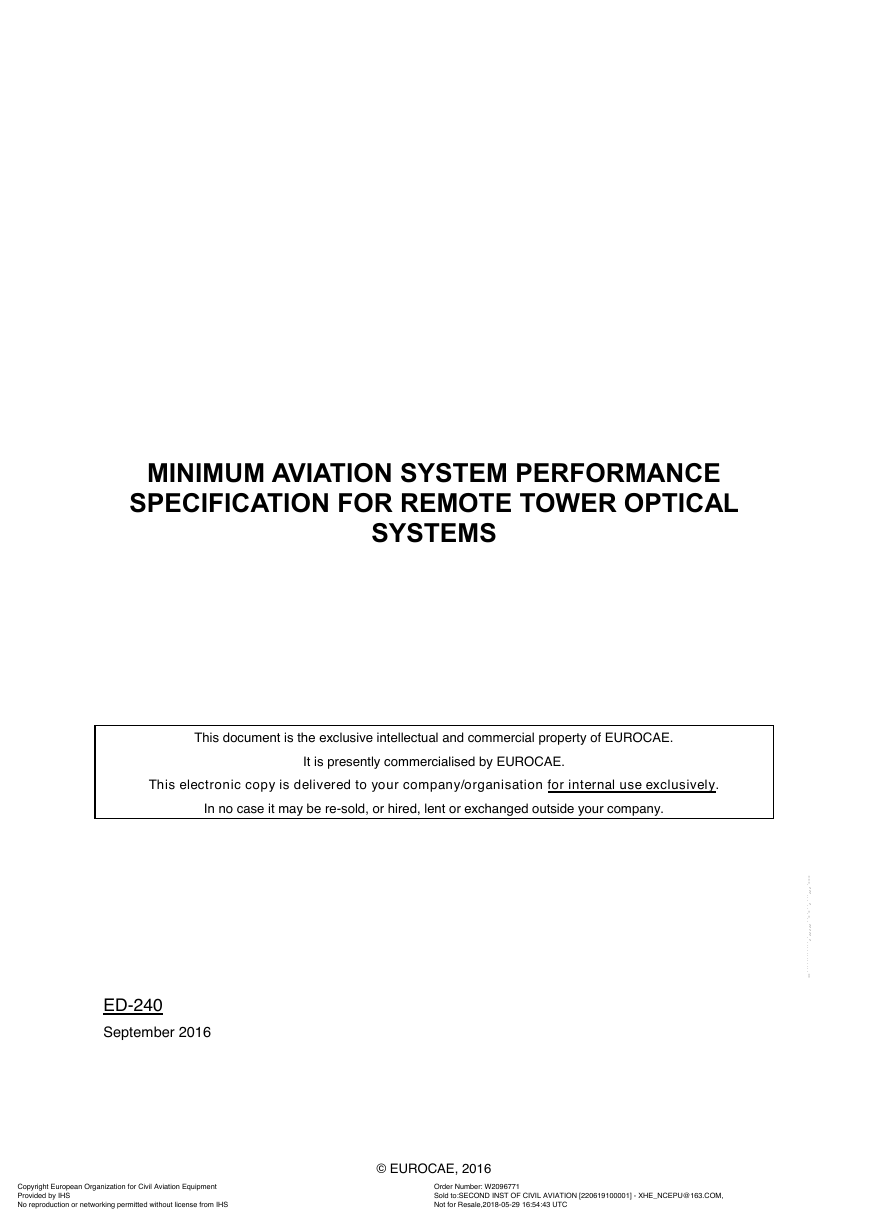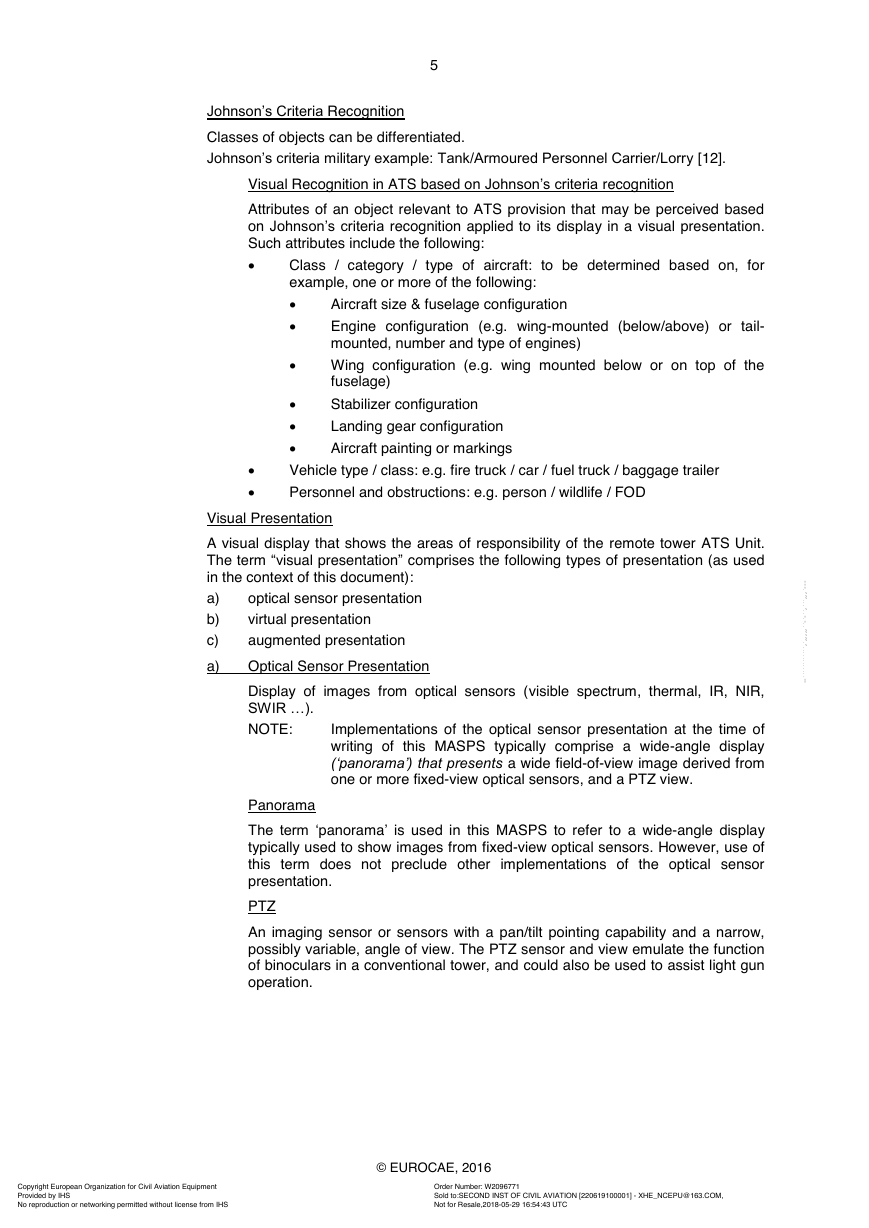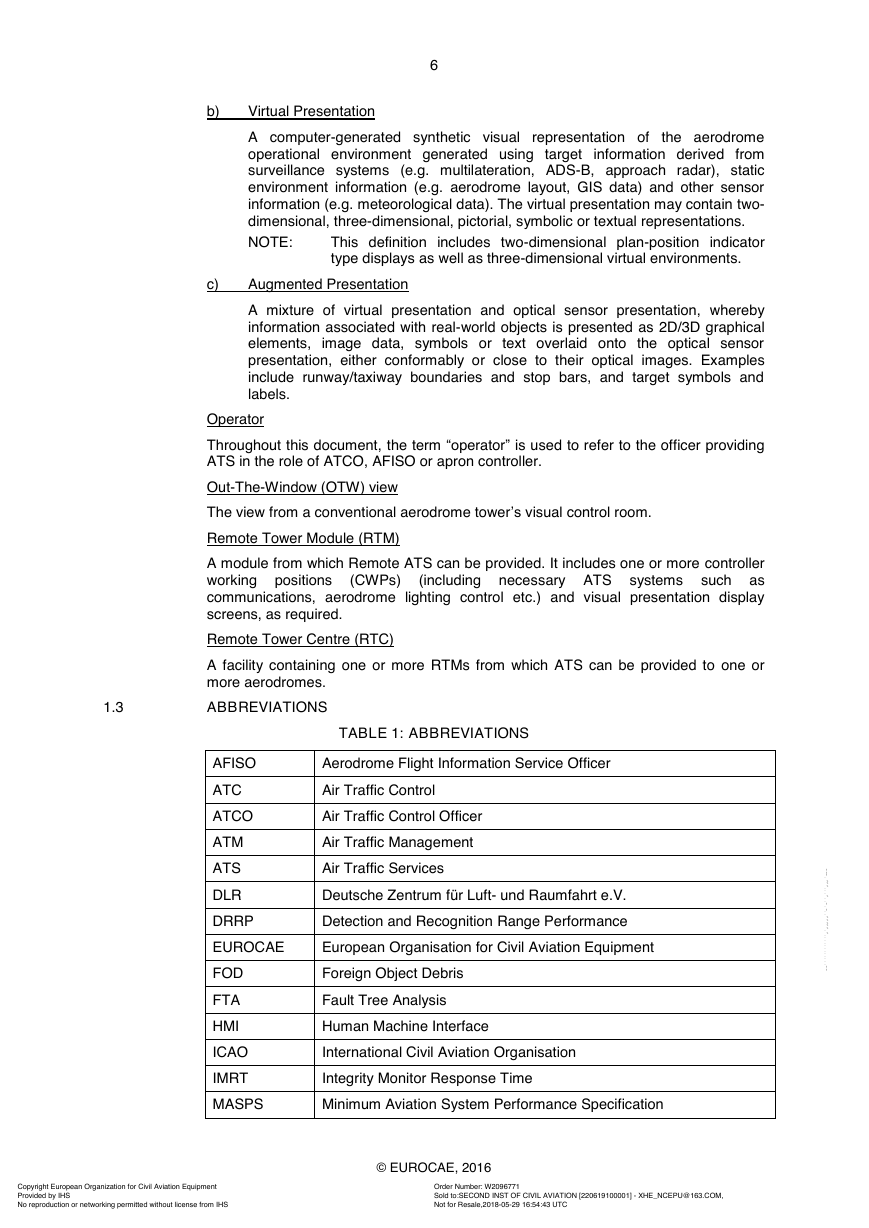The European Organisation for Civil Aviation Equipment
L’Organisation Européenne pour l’Equipement de l’Aviation Civile
MINIMUM AVIATION SYSTEM PERFORMANCE
SPECIFICATION FOR REMOTE TOWER OPTICAL
SYSTEMS
This document is the exclusive intellectual and commercial property of EUROCAE.
It is presently commercialised by EUROCAE.
This electronic copy is delivered to your company/organisation for internal use exclusively.
In no case it may be re-sold, or hired, lent or exchanged outside your company.
ED-240
September 2016
102 rue Etienne Dolet
92240 MALAKOFF, France
Web Site: www.eurocae.net
Tel: 33 1 40 92 79 30
Fax: 33 1 46 55 62 65
Email: eurocae@eurocae.net
Copyright European Organization for Civil Aviation Equipment Provided by IHSOrder Number: W2096771Sold to:SECOND INST OF CIVIL AVIATION [220619100001] - XHE_NCEPU@163.COM, Not for Resale,2018-05-29 16:54:43 UTCNo reproduction or networking permitted without license from IHS--````````````,`,,,,,``-`-``,```,,,`---�
MINIMUM AVIATION SYSTEM PERFORMANCE
SPECIFICATION FOR REMOTE TOWER OPTICAL
SYSTEMS
This document is the exclusive intellectual and commercial property of EUROCAE.
It is presently commercialised by EUROCAE.
This electronic copy is delivered to your company/organisation for internal use exclusively.
In no case it may be re-sold, or hired, lent or exchanged outside your company.
ED-240
September 2016
© EUROCAE, 2016
Copyright European Organization for Civil Aviation Equipment Provided by IHSOrder Number: W2096771Sold to:SECOND INST OF CIVIL AVIATION [220619100001] - XHE_NCEPU@163.COM, Not for Resale,2018-05-29 16:54:43 UTCNo reproduction or networking permitted without license from IHS--````````````,`,,,,,``-`-``,```,,,`---�
i
FOREWORD
1.
2.
3.
4.
This document was prepared by EUROCAE Working Group 100
“Remote & Virtual Tower (RVT)” and was approved by the Council of
EUROCAE on 7 September 2016.
EUROCAE is an international non-profit making organisation in Europe.
Membership is open to manufacturers and operators of equipment for
aeronautics, trade associations, national civil aviation administrations, and,
under certain conditions, non-European organisations. Its work programme is
principally directed to the preparation of performance specifications and
guidance documents for civil aviation equipment, for adoption and use at
European and world-wide levels.
The findings of EUROCAE are resolved after discussion amongst Members of
EUROCAE.
performance
EUROCAE
are
recommendations only. EUROCAE is not an official body of the European
Governments. Its recommendations are valid as statements of official policy
only when adopted by a particular government or conference of governments.
specifications
and
other
documents
5.
Copies of this document may be obtained from:
EUROCAE
102, rue Etienne Dolet
92240 MALAKOFF
France
Telephone: 33 1 40 92 79 30
Fax: 33 1 46 55 62 65
Email: eurocae@eurocae.net
Website: www.eurocae.net
© EUROCAE, 2016
Copyright European Organization for Civil Aviation Equipment Provided by IHSOrder Number: W2096771Sold to:SECOND INST OF CIVIL AVIATION [220619100001] - XHE_NCEPU@163.COM, Not for Resale,2018-05-29 16:54:43 UTCNo reproduction or networking permitted without license from IHS--````````````,`,,,,,``-`-``,```,,,`---�
ii
TABLE OF CONTENTS
FOREWORD
........................................................................................................................................ i
CHAPTER 1 GENERAL ..................................................................................................................... 4
1.1
1.2
1.3
1.4
1.5
1.6
1.7
INTRODUCTION ............................................................................................ 4
DEFINITION OF TERMS ............................................................................... 4
ABBREVIATIONS........................................................................................... 6
PURPOSE AND SCOPE ................................................................................ 7
OPERATIONAL CONTEXT ............................................................................ 7
TECHNICAL CONTEXT ................................................................................. 8
REFERENCES ............................................................................................... 8
CHAPTER 2 SYSTEM DESCRIPTION .............................................................................................. 9
2.1
2.2
2.3
2.4
2.5
2.6
2.7
2.8
2.9
INTRODUCTION ............................................................................................ 9
OPTICAL SENSORS.................................................................................... 10
ENCODER / PROCESSING ........................................................................ 10
NETWORK ................................................................................................... 10
DECODER / PROCESSING ........................................................................ 10
OPTICAL SENSOR PRESENTATION ......................................................... 10
PTZ FUNCTION ........................................................................................... 10
CONTROL HMI ............................................................................................ 10
TIMESOURCE .............................................................................................. 11
CHAPTER 3 SYSTEM PERFORMANCE REQUIREMENTS ........................................................... 12
3.1
3.2
3.3
3.4
3.5
3.6
3.7
3.8
INTRODUCTION .......................................................................................... 12
DETECTION AND RECOGNITION RANGE PERFORMANCE................... 12
VIDEO LATENCY PERFORMANCE ............................................................ 15
VIDEO UPDATE RATE PERFORMANCE ................................................... 15
VIDEO FAILURE DETECTION TIME PERFORMANCE ............................. 15
PTZ FUNCTION CONTROL LATENCY PERFORMANCE.......................... 15
PTZ FUNCTION MOVEMENT SPEED PERFORMANCE ........................... 15
TIME SYNCHRONISATION ......................................................................... 15
CHAPTER 4
INTEROPERABILITY REQUIREMENTS .................................................................... 16
4.1
SYSTEM INTEGRITY................................................................................... 16
4.1.1
Integrity Monitor Response Time (IMRT) ..................................................... 17
4.2
4.2.1
4.2.2
4.3
SYSTEM AVAILABILITY AND CONTINUITY OF SERVICE ....................... 17
Mean Time between Critical Failures (MTBCF) ........................................... 18
Mean Time to Repair (MTTR) ...................................................................... 18
DEPENDABILITY AND INTEROPERABILITY PERFORMANCE ................ 18
© EUROCAE, 2016
Copyright European Organization for Civil Aviation Equipment Provided by IHSOrder Number: W2096771Sold to:SECOND INST OF CIVIL AVIATION [220619100001] - XHE_NCEPU@163.COM, Not for Resale,2018-05-29 16:54:43 UTCNo reproduction or networking permitted without license from IHS--````````````,`,,,,,``-`-``,```,,,`---�
iii
CHAPTER 5 PERFORMANCE VERIFICATION .............................................................................. 19
5.1
5.2
5.3
5.4
5.5
5.6
5.7
5.8
5.9
5.9.1
5.9.2
5.9.3
TEST DESCRIPTION ................................................................................... 19
DETECTION AND RECOGNITION RANGE PERFORMANCE................... 19
VIDEO LATENCY PERFORMANCE ............................................................ 20
VIDEO UPDATE RATE PERFORMANCE ................................................... 21
VIDEO FAILURE DETECTION PERFORMANCE ....................................... 21
PTZ FUNCTION CONTROL LATENCY PERFORMANCE.......................... 22
PTZ FUNCTION MOVEMENT SPEED PERFORMANCE ........................... 23
TIME SYNCHRONISATION ......................................................................... 23
SYSTEM DEPENDABILITY AND INTEROPERABILITY ............................. 24
Integrity Monitor Response Time (IMRT) ..................................................... 26
Mean Time Between Critical Failures (MTBCF) ........................................... 26
Mean Time To Repair (MTTR) ..................................................................... 27
APPENDIX 1 REQUIREMENT / TEST CASE CORRESPONDENCE MATRIX ................................. 28
APPENDIX 2 DRRP EXAMPLE VALIDATION .................................................................................. 29
APPENDIX 3 WG-100 MEMBERSHIP ................................................................................................ 30
IMPROVEMENT SUGGESTION FORM ............................................................................................... 33
LIST OF FIGURES
FIGURE 1: REMOTE TOWER OPTICAL SYSTEM CONCEPTUAL BUILDING BLOCKS .................. 9
FIGURE 2: NTPQ OUTPUT EXAMPLE ............................................................................................... 24
LIST OF TABLES
TABLE 1: ABBREVIATIONS .................................................................................................................. 6
TABLE 2: SCOPE OF THIS MASPS DOCUMENT ................................................................................. 7
TABLE 3: SAMPLE MATRIX FOR CREATING AERODROME SPECIFIC DRRP ............................... 14
TABLE 4: DEPENDABILITY AND INTEROPERABILITY PERFORMANCE REQUIREMENTS ......... 18
TABLE 5: VERIFICATION TECHNIQUES FOR SYSTEM DEPENDABILITY AND
INTEROPERABILITY .......................................................................................................... 25
© EUROCAE, 2016
Copyright European Organization for Civil Aviation Equipment Provided by IHSOrder Number: W2096771Sold to:SECOND INST OF CIVIL AVIATION [220619100001] - XHE_NCEPU@163.COM, Not for Resale,2018-05-29 16:54:43 UTCNo reproduction or networking permitted without license from IHS--````````````,`,,,,,``-`-``,```,,,`---�
4
CHAPTER 1
GENERAL
1.1
INTRODUCTION
ICAO has recommended the development of provisions for remotely-operated Air
Traffic Services (ATS),
for surveillance and
communications, providing requirements for sensors and display technologies to
replace visual observation, and providing requirements for personnel licensing and
training [1]).
including updating requirements
The use of remote tower technology enables the provision of aerodrome ATS as
defined in ICAO Document 4444 [2], EUROCONTROL’s Manual for Aeronautical
Flight Information Service (AFIS) [3] and ICAO Document 9426 [4] from a location
from which provision of ATS by direct visual observation is not possible. A remote
tower facility could be several hundred kilometres from the aerodrome it is providing
service to, or it could be located in a building on or near the aerodrome but without an
adequate direct view of the area of control responsibility.
ICAO Document 9426 (Part III) [4] states that an aerodrome tower is required to
“permit the controller to visually survey those portions of the aerodrome and its vicinity
over which they exercise control”. In the switch from a conventional tower to a remote
tower facility, the primary change relates to the manner by which the above provision
is satisfied. The view from a conventional tower (the "out-of-the-window" (OTW) view)
facilitates visual survey in line with the ICAO regulation. When operating from a
remote tower facility, visual observation of the aerodrome is no longer carried out by
directly observing the OTW view. Instead, a remote tower optical system, comprising
cameras at the aerodrome and a display presentation to the remote operator, are
provided to enable situational awareness.
The remote tower visual presentation is one of the principle components that enables
the provision of ATS from a remote tower facility or from environments where an
existing aerodrome tower OTW view is inadequate for providing ATS. An optical
sensor presentation is a type of visual presentation that displays video images from
cameras, which could be infrared as well as visible spectrum devices.
This Minimum Aviation System Performance Specification (MASPS) document
pertains to remote tower optical systems, and is applicable to all optical sensor
configurations that could be used to implement remotely-operated ATS for an
aerodrome. The specific configuration of the optical system will be a matter for
individual implementations.
1.2
DEFINITION OF TERMS
NOTE:
Some terms provided below are taken from ICAO documents, EASA
Annex to ED Decision 2015/014/R or SESAR Documents [2][6][11].
The following defined terms are used within the context of this document.
Air Traffic Services
A generic term meaning variously, flight information service, alerting service, air traffic
advisory service, or air traffic control service (area control service, approach control
service or aerodrome control service).
Johnson’s Criteria Detection
Something in an image that raises an observer’s attention.
Johnson’s Criteria Military example: “There is something!” [12]
Visual Detection in ATS based on Johnson’s Criteria Detection
Johnson’s detection criteria applied to images of objects relevant to the
provision of ATS displayed in a visual presentation.
Same as for Johnson’s criteria detection: “There is something!”
© EUROCAE, 2016
Copyright European Organization for Civil Aviation Equipment Provided by IHSOrder Number: W2096771Sold to:SECOND INST OF CIVIL AVIATION [220619100001] - XHE_NCEPU@163.COM, Not for Resale,2018-05-29 16:54:43 UTCNo reproduction or networking permitted without license from IHS--````````````,`,,,,,``-`-``,```,,,`---�
5
Johnson’s Criteria Recognition
Classes of objects can be differentiated.
Johnson’s criteria military example: Tank/Armoured Personnel Carrier/Lorry [12].
Visual Recognition in ATS based on Johnson’s criteria recognition
Attributes of an object relevant to ATS provision that may be perceived based
on Johnson’s criteria recognition applied to its display in a visual presentation.
Such attributes include the following:
Class / category / type of aircraft: to be determined based on, for
example, one or more of the following:
Aircraft size & fuselage configuration
Engine configuration (e.g. wing-mounted (below/above) or tail-
mounted, number and type of engines)
Wing configuration (e.g. wing mounted below or on top of the
fuselage)
Stabilizer configuration
Landing gear configuration
Aircraft painting or markings
Vehicle type / class: e.g. fire truck / car / fuel truck / baggage trailer
Personnel and obstructions: e.g. person / wildlife / FOD
Visual Presentation
A visual display that shows the areas of responsibility of the remote tower ATS Unit.
The term “visual presentation” comprises the following types of presentation (as used
in the context of this document):
a)
b)
c)
optical sensor presentation
virtual presentation
augmented presentation
a) Optical Sensor Presentation
Display of images from optical sensors (visible spectrum, thermal, IR, NIR,
SWIR …).
NOTE:
Implementations of the optical sensor presentation at the time of
writing of this MASPS typically comprise a wide-angle display
(‘panorama’) that presents a wide field-of-view image derived from
one or more fixed-view optical sensors, and a PTZ view.
Panorama
The term ‘panorama’ is used in this MASPS to refer to a wide-angle display
typically used to show images from fixed-view optical sensors. However, use of
this term does not preclude other implementations of the optical sensor
presentation.
PTZ
An imaging sensor or sensors with a pan/tilt pointing capability and a narrow,
possibly variable, angle of view. The PTZ sensor and view emulate the function
of binoculars in a conventional tower, and could also be used to assist light gun
operation.
© EUROCAE, 2016
Copyright European Organization for Civil Aviation Equipment Provided by IHSOrder Number: W2096771Sold to:SECOND INST OF CIVIL AVIATION [220619100001] - XHE_NCEPU@163.COM, Not for Resale,2018-05-29 16:54:43 UTCNo reproduction or networking permitted without license from IHS--````````````,`,,,,,``-`-``,```,,,`---�
6
b)
Virtual Presentation
A computer-generated synthetic visual representation of the aerodrome
operational environment generated using target information derived from
surveillance systems (e.g. multilateration, ADS-B, approach radar), static
environment information (e.g. aerodrome layout, GIS data) and other sensor
information (e.g. meteorological data). The virtual presentation may contain two-
dimensional, three-dimensional, pictorial, symbolic or textual representations.
NOTE:
This definition includes two-dimensional plan-position indicator
type displays as well as three-dimensional virtual environments.
c)
Augmented Presentation
A mixture of virtual presentation and optical sensor presentation, whereby
information associated with real-world objects is presented as 2D/3D graphical
elements, image data, symbols or text overlaid onto the optical sensor
presentation, either conformably or close to their optical images. Examples
include runway/taxiway boundaries and stop bars, and target symbols and
labels.
Operator
Throughout this document, the term “operator” is used to refer to the officer providing
ATS in the role of ATCO, AFISO or apron controller.
Out-The-Window (OTW) view
The view from a conventional aerodrome tower’s visual control room.
Remote Tower Module (RTM)
A module from which Remote ATS can be provided. It includes one or more controller
working positions
(including necessary ATS systems such as
communications, aerodrome lighting control etc.) and visual presentation display
screens, as required.
(CWPs)
Remote Tower Centre (RTC)
A facility containing one or more RTMs from which ATS can be provided to one or
more aerodromes.
1.3
ABBREVIATIONS
AFISO
ATC
ATCO
ATM
ATS
DLR
TABLE 1: ABBREVIATIONS
Aerodrome Flight Information Service Officer
Air Traffic Control
Air Traffic Control Officer
Air Traffic Management
Air Traffic Services
Deutsche Zentrum für Luft- und Raumfahrt e.V.
DRRP
Detection and Recognition Range Performance
EUROCAE
European Organisation for Civil Aviation Equipment
FOD
FTA
HMI
ICAO
IMRT
Foreign Object Debris
Fault Tree Analysis
Human Machine Interface
International Civil Aviation Organisation
Integrity Monitor Response Time
MASPS
Minimum Aviation System Performance Specification
© EUROCAE, 2016
Copyright European Organization for Civil Aviation Equipment Provided by IHSOrder Number: W2096771Sold to:SECOND INST OF CIVIL AVIATION [220619100001] - XHE_NCEPU@163.COM, Not for Resale,2018-05-29 16:54:43 UTCNo reproduction or networking permitted without license from IHS--````````````,`,,,,,``-`-``,```,,,`---�
















 2023年江西萍乡中考道德与法治真题及答案.doc
2023年江西萍乡中考道德与法治真题及答案.doc 2012年重庆南川中考生物真题及答案.doc
2012年重庆南川中考生物真题及答案.doc 2013年江西师范大学地理学综合及文艺理论基础考研真题.doc
2013年江西师范大学地理学综合及文艺理论基础考研真题.doc 2020年四川甘孜小升初语文真题及答案I卷.doc
2020年四川甘孜小升初语文真题及答案I卷.doc 2020年注册岩土工程师专业基础考试真题及答案.doc
2020年注册岩土工程师专业基础考试真题及答案.doc 2023-2024学年福建省厦门市九年级上学期数学月考试题及答案.doc
2023-2024学年福建省厦门市九年级上学期数学月考试题及答案.doc 2021-2022学年辽宁省沈阳市大东区九年级上学期语文期末试题及答案.doc
2021-2022学年辽宁省沈阳市大东区九年级上学期语文期末试题及答案.doc 2022-2023学年北京东城区初三第一学期物理期末试卷及答案.doc
2022-2023学年北京东城区初三第一学期物理期末试卷及答案.doc 2018上半年江西教师资格初中地理学科知识与教学能力真题及答案.doc
2018上半年江西教师资格初中地理学科知识与教学能力真题及答案.doc 2012年河北国家公务员申论考试真题及答案-省级.doc
2012年河北国家公务员申论考试真题及答案-省级.doc 2020-2021学年江苏省扬州市江都区邵樊片九年级上学期数学第一次质量检测试题及答案.doc
2020-2021学年江苏省扬州市江都区邵樊片九年级上学期数学第一次质量检测试题及答案.doc 2022下半年黑龙江教师资格证中学综合素质真题及答案.doc
2022下半年黑龙江教师资格证中学综合素质真题及答案.doc